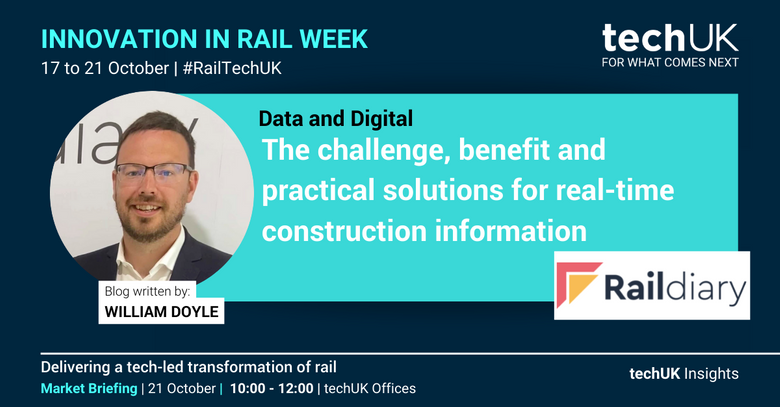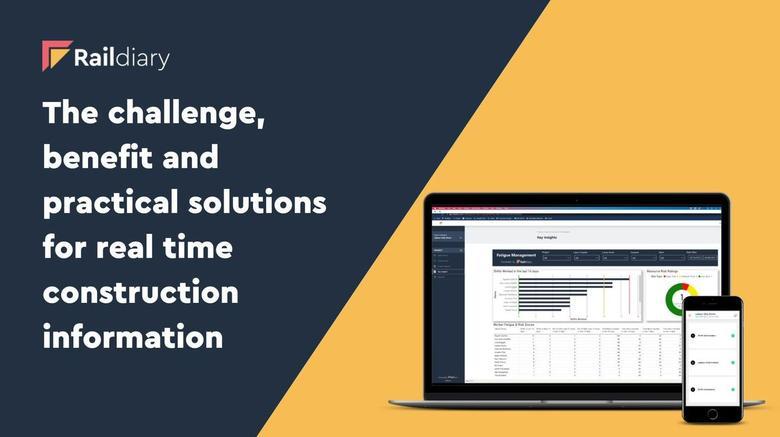The challenge, benefit and practical solutions for real-time construction information (Guest blog by Raildiary)

We are experiencing exponential data growth in an industry that is both information-driven and information-centric. We need to understand how to capture, report and analyse data in order to be agile and efficient. Part of the problem lies in how this information is being stored, often in unstructured, disparate ways without a clear strategy to inform planning and reporting.
Often our data is disconnected and inhibits us from benefiting from trends and insights. A recent Autodesk survey reported that the volume of available project data has doubled in the last 3 years. Some other numbers from this report which highlight the scale of the problem -
• Worldwide cost of poor decisions based on inadequate data - $1.84 trillion.
• Poor data may have led to nearly 15% of all construction rework.
• This may have caused nearly $90bn in avoidable rework.
So the challenge is huge and clearly the prize is worth working towards. It’s worth exploring the numerous other benefits not directly linked to cost savings too…
Benefits
Direct cost savings are the obvious potential benefit of capturing real time construction data however there are several other tangible and intangible outcomes that can be harnessed through best practice -
- Transparency - modern construction projects supported by progressive contracting models require greater levels of transparency. This can be problematic in an industry traditionally collating data in silos and aggregating it over several weeks for project wide reporting. Real time construction data accessible to all stakeholders provides radical transparency supporting these processes.
- Trust - transparency leads to trust. Shared, real time data, objectively recorded in a structured format delivers the foundation for trust in supplier and client relationships. No longer are clients or asset owners waiting until month end to receive a reporting pack considered subjective rather than contemporaneous access to consistently updated commercial data.
- Collaborative problem solving - the combination of transparency and trust leads to a space where real time collaboration around risk management becomes common practice. Sharing this data allows teams to mitigate risk, manage issues and exploit opportunities rapidly. The flip side of this approach is mole hills becoming mountains and issues being uncovered at a point where simple solutions may not be applicable.
- Long term learning - imagine building the next mega project and having access to all the site data captured on the previous project. This could be Crossrail, HS2, Hinkley Point or numerous other large scale projects which last for several years and often over a decade. If we can capture real time data consistently in a recognised structured format then we can unlock learning for future projects or even later stages of the same project.

Practical solutions
Real time data management is no longer about collecting data and storing it for later, but rather having the right information at the right time to make better decisions. In this world of exponential data growth what practical solutions are there to cutting through to exploit the benefits of this information?
- Critical production metrics (not all) - the ability to capture data is growing as quickly as the data sets themselves giving us access to an almost infinite number of metrics for measuring progress on site. Not all data is created equal and on every construction project there will be a “killer” metric linked to production which impacts directly the critical path of a programme. This could be anything from design tasks to groundworks to testing and commissioning. Once this metric is identified, focusing on it relentlessly and understanding what has a positive impact is key to real time data analysis.
- Visualisations and scoring - not everyone consumes and understands data in the same way. Some people deal in numbers and others pictures. A combination of scoring and visualising data is key to ensure all those analysing real time data may extract the intrinsic value being collected.
- Notifications - a simple but important factor in a busy world. Once we’ve identified the critical production metrics and understand the levers that influence success we need to ensure that those with the power to make decisions are notified and kept informed when things change.
- Geotagged, BIM model and asset tagged information - context is important for all data and this is especially important on large construction projects. Having the ability to tag real time data to it’s geolocation or linked to a BIM model or asset register provides an additional layer of context supporting short term decision making and long term learning.
The challenge of real time data is huge however the benefits are even greater and practical solutions can be simple and cost effective to implement. Real time data allows you to make better decisions, save money, and save time. The more time you spend managing your information, the less time you have for managing your projects.
Get involved with our work
All of techUK’s work is led by our members – keep in touch or get involved with our work on transport and infrastructure by joining our groups.




